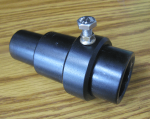robert.brown
Newbie
very unsual
Kolibri;n1121273 said:RAFSA owner Eben Mocke Snr walked into a prop last month and lost an arm.
This incident is a reminder to us all to pay very careful attention while working on a running engine.


Kolibri;n1138366 said:My RAF prerotator clutch has the old extension for the cable. The shorter clutch shaft does away with this extension, and is preferable (requiring less cable bend), but is available only from RAF/RAFSA (or custom made).
Threaded into that aluminum is a .25x28 bolt to secure the p/r cable end. In order to often grease the cable, this bolt must be loosened, and over the years the aluminum threads give way.
Here's a solution that works for me: a machined steel collar drilled/tapped for the bolt.
Drill out the existing hole in the extension.
Bead-blast and paint with Krylon Hi-Heat Satin Black, which nicely matches the anodized aluminum.
(The stainless bolt pictured was all I had on hand for photo; a cadmium bolt was later used in the part.)
Any jam nut will do, but I used a heat nut.
Secondary retention for the cable ends is a wise precaution.
Regards,
Kolibri
You mean the ones you added a steel bushing to inside, increasing the weight? :wink:I have been selling my improved RAF mast bushing for a couple of months now
Kolibri;n1138465 said:However, when I installed a custom $500 stainless steel exhaust system that shaved off many pounds from the OEM pig iron RAF exhaust, did you praise my having done so?
In fact, with that, and the heavier redrive plate, it's not only an overall weight wash, but I slightly raised the cg which slightly reduced the prop thrust offset.
Kolibri;n1138465 said:However, when I installed a custom $500 stainless steel exhaust system that shaved off many pounds from the OEM pig iron RAF exhaust, did you praise my having done so?
eddie, feel free to toss out more of your soft pitches.All you did was replace about 2' of steel exhaust pipe,you used the stock Subaru headers and replaced the muffler with
another stock OEM one,there was no weight savings as you claim, stainless weighs the same as cold rolled steel,and some stainless actually weighs more.
So whats there to praise,it certainly is not your claim of weight savings,maybe its the fact that you got ripped for $500 bucks

